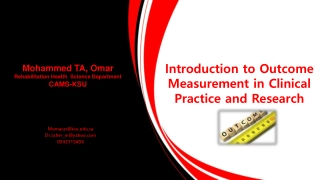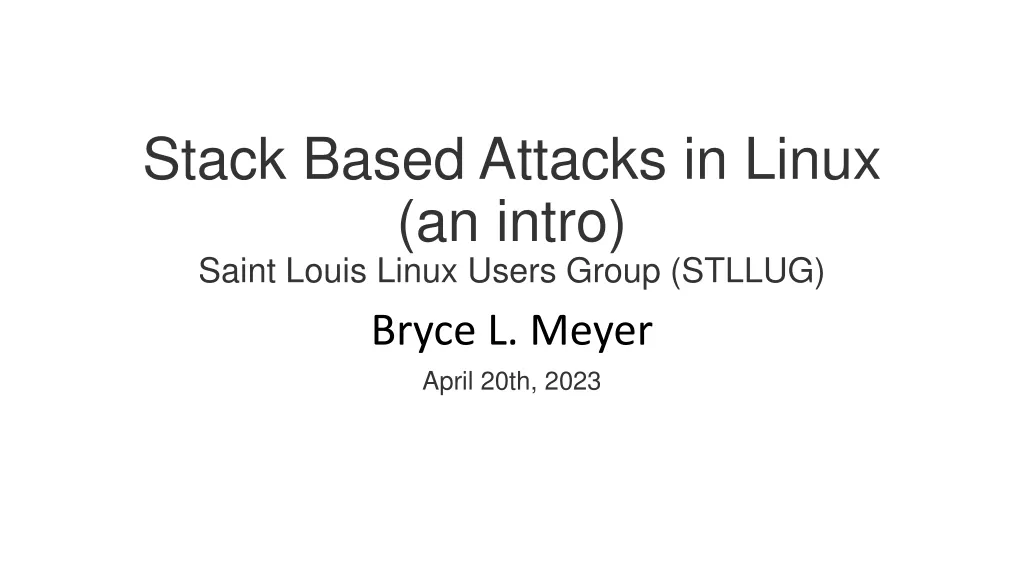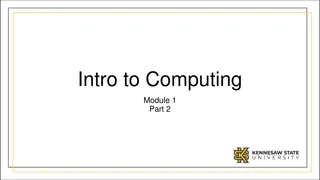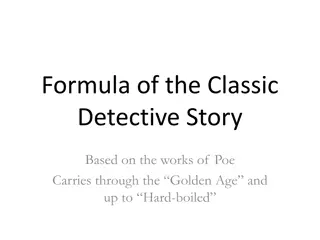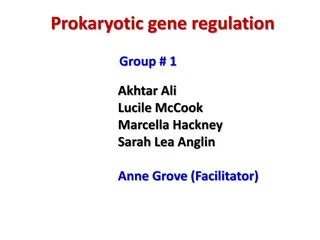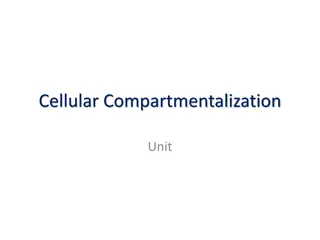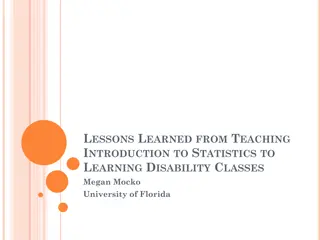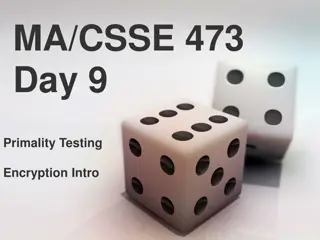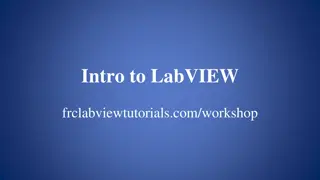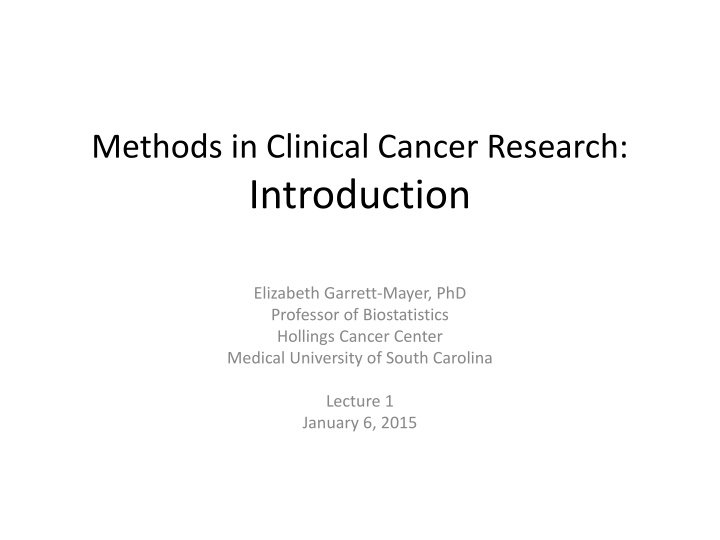
Advanced Course in Clinical Cancer Research
Enhance your knowledge in clinical cancer research with this advanced course focusing on trial design, patient outcomes, and protocol review. Gain hands-on experience through didactic lectures and journal club discussions.
Download Presentation

Please find below an Image/Link to download the presentation.
The content on the website is provided AS IS for your information and personal use only. It may not be sold, licensed, or shared on other websites without obtaining consent from the author. If you encounter any issues during the download, it is possible that the publisher has removed the file from their server.
You are allowed to download the files provided on this website for personal or commercial use, subject to the condition that they are used lawfully. All files are the property of their respective owners.
The content on the website is provided AS IS for your information and personal use only. It may not be sold, licensed, or shared on other websites without obtaining consent from the author.
E N D
Presentation Transcript
Methods in Clinical Cancer Research: Introduction Elizabeth Garrett-Mayer, PhD Professor of Biostatistics Hollings Cancer Center Medical University of South Carolina Lecture 1 January 6, 2015
Methods in Clinical Cancer Research Course website: http://people.musc.edu/~elg26/teaching/MCCR2015/MCCR2015.htm Tuesdays and Thursdays, 1:30-3pm BSB302 Primary Instructor email: garrettm@musc.edu
Course Objectives At the end of the course, students should be able to: Understand the key components required for designing, activating and implementing a cancer clinical trial. Write a proposal for a cancer clinical trial, including objectives, endpoints, trial design, patient population selection, and have some understanding of the required sample size and analytic techniques used to analyze the data at the end of the trial. Effectively review and critique clinical trial protocols and published cancer clinical trials research.
Course Description Didactic lectures will cover the following areas: (1) clinical and statistical design of phase I, II and III trials; (2) incorporation of correlative and biomarkers in clinical trials, (3) considerations in chemotherapy, surgery, radiation and multimodality trials, (4) quality of life and other patient reported outcomes in cancer research, (5) the protocol review and IRB process, (6) informed consent, (7) data collection, trial monitoring and investigator responsibilities, (8) grants, cooperative groups in oncology and pharma. Other topics are incorporated as well, (e.g., disparities research). In addition to the didactic portions of the training, each trainee will have a clinical research proposal which will be developed into a letter of intent (LOI) for a clinical trial. In addition to the didactic sessions , contact hours will take the form of a journal club where clinical research papers from journals such as Clinical Cancer Research or Journal of Clinical Oncology are discussed, and protocols that are being undertaken at HCC are reviewed and discussed. Trainees will also be required to attend and take part in the HCC Protocol Review Committee s monthly meetings (meetings occur every 3 weeks). This will allow the trainees to be exposed to a variety of studies ranging from Phase I to III cancer trials, in addition to observational, translational and qualitative research studies. Trainees will also be encouraged to attend one or more of the HCC Data Safety and Monitoring Board meetings to gain exposure to issues of trial review and monitoring.
Texts and Assessments Recommended Texts for Reference: Clinical Trials: A Methodologic Perspective (Piantadosi) Oncology Clinical Trials (Kelly & Halabi) Principles of Anti-Cancer Drug Development (Hidalgo, Eckhardt, Garrett-Mayer, Clendennin) Assessment of Students: Students will be graded based on the following components where each assignment is given numeric score, according to the Merit Grades for the MUSC grading system. Written reviews of protocols, given as assignments. There will be 3-4 protocols assigned and the review will be structured with particular questions about appropriateness of study design, clarity of the study aims, incorporation of early stopping rules in the trial design, etc. (45% of grade) Oral presentation of journal article presenting results of a cancer clinical trial. The article will be selected by the student and Dr. Garrett-Mayer. The student will present to the class an overall summary of the trial and provide a critique of the methods employed. (25% of grade) Submitted LOI: The LOI will be submitted twice. First, a draft will be submitted about two-thirds through the course. Dr. Garrett-Mayer will provide feedback. This first draft will constitute 15% of the total grade. The final LOI will be submitted as the final and will also count for 15% of the course grade. Total: 30% of grade
Assignments policy Homeworks are due by 5pm on the due date. All homeworks should be emailed to the primary instructor (garrettm@musc.edu) or turned in at lecture time. Asking for extensions on homeworks is strongly discouraged. However, it is expected that, on occasion, extenuating circumstances may arise. Therefore, the policy is that each student may request an extension on homework twice and the extension is to be no more than 2 days. You must notify the primary instructor that you are requesting an extension before the time the assignment is due. After using two extensions, no more extensions will be granted except with a medical note.
Classroom Etiquette Attention to material: Laptops are permitted in class, but it is expected that if they are used, it is to follow along with the lecture. Email and web browsers should not be visited during class time. Checking phones during lecture is not acceptable. The instructors are giving their time and expertise. Be respectful and give them your attention. Classroom disruptions: Some of us have patients, clinic staff, family members and others who we need to be able to be in contact with during lectures. It is acceptable to bring pagers or cell phones to class. Please be sure they are on silent mode. If you need to leave during lecture to take a phone call, or make a phone call, please do so. However, this should be a relatively rare occurrence. Texting and emailing during lecture time is not acceptable.
Schedule (work in progress) Tentative Lecture Schedule: Lecture number 1 Date Topic Instructor Tu Jan 6 Th Jan 8 Tu Jan 13 Th Jan 15 Introduction Phase I trials: practical considerations Phase I trial designs Phase I in practice: current topics/controversies Phase II trials: practical considerations Phase II trial designs Phase II in practice: current topics/controversies Phase III trials: practical considerations Phase III trial designs Phase III trials: practical considerations Observational studies Biomarker clinical trial designs EGM EGM Britten? Britten? 2 3 4 5 Tu Jan 20 Th Jan 22 Tu Jan 27 EGM EGM EGM 6 7 8 Th Jan 29 Tu Feb 3 Th Feb 5 Tu Feb 10 Th Feb 12 Tu Feb 17 Th Feb 19 Tu Feb 24 EGM EGM EGM 9 10 11 12 EGM 13 14 Endpoint selection issues Power calculations EGM EGM 15
Schedule (work in progress) Tentative Lecture Schedule: 16 17 18 19 Th Feb 26 Tu Mar 3 Th Mar 5 Tu Mar 10 Th Mar 12 Tu Mar 17 Th Mar 19 Tu Mar 24 Th Mar 26 Tu Mar 31 Th Apr 2 Tu Apr 7 Th Apr 9 Tu Apr 14 Th Apr 16 Tu Apr 21 Th Apr 23 Tu Apr 28 Correlative studies Imaging endpoints Quality of Life and patient reported outcomes Spring break (no class) Spring break (no class) Data collection and privacy issues Informed consent Protocol review and IRB process Data safety and monitoring Disparities research Prevention and Control studies Data safety and monitoring Grants, cooperative groups and pharma Radiation and Multimodality Trials Tobacco Cessation in Clinical Cancer Trials Prediction vs. Association Intention to Treat and Compliance EGM Ravenel Sterba EGM Stuart EGM EGM Ford Wallace EGM EGM Graham Warren Graham Warren 20 21 22 23 24 25 26 27 28 29 30 31
Lecture Notes Every lecturer will have his/her own style Notes may be prepared ahead of time and posted Prepared and posted after the lecture Nonexistent Lecture notes will NOT be printed by the instructors prior to lecture. If they are available and you would like a paper copy, it is your responsibility to print them out.
Heterogeneous Population K-12 Training Program Biostats & Epi grad students
Types of Research Studies in Cancer Basic Science Translational Clinical Exploratory/Pilot/Correlative Phase I Phase II Phase III Other: e.g. prevention, survivorship Epidemiological
Phases of Drug Development Phase I Dose finding Usually designed to find the highest safe dose. 12-30 patients. 2014 update: 12 - 700 Phase II Preliminary efficacy and safety Generally not head to head comparison 20-80 patients Phase III Definitive comparative trial against the standard of care Usually hundreds or thousands of patients
Clinical Trials: the beginning Write a clinical trial protocol Usually 70-180 pages Not like writing a grant Every detail spelled out: no page limit! There are standard templates that can/should be used.
Imagine. You are principal investigator (PI) of a clinical trial In the middle of the trial, you change careers You are now an astronaut and fly to the moon Meanwhile, a new patient is enrolled. The new PI needs to know: How should the patient be assigned to a dose? How should dose modifications occur? What measurements should be taken and when? What are the definition of the primary and 2ndary outcomes? Who and how are the data to be reviewed for safety and efficacy?
Statistical design and development of clinical trials Statistical considerations permeate the design and analytic plan Requires interaction with your statistician Early interaction! Before the design (and budget) are set in stone. bad: i have almost finished writing the protocol, and then i will send to you to insert a statistical plan
Where are the statisticians? Academic cancer centers have biostatistics cores or biostatistics shared resources It is the role of these biostatisticians to help design clinical trials Find them! Other places: University settings usually have biostatistics departments or divisions Pharma will have biostatisticians on site or have biostatistical consultants available Small pharma/biotech will contract from CROs . Cooperative groups have statistical teams familiar with the group and its trials.
Statistical Considerations: 5 part process I. Stating research aims/objectives II. Determining your outcome measures III. Choosing the experimental design IV. The analytic plan V. Sample size justification (note: there are MANY other parts to the protocol! These are just the stats considerations).
Motivating Example Randomized Phase II study evaluating two administration schedules of flavopiridolgiven in timed sequential combination with cytosine arabinoside (ara-C) and mitoxantrone for adults with newly diagnosed, previously untreated, poor-risk acute myelogenous leukemias (AML)* Principal Investigator: Judy Karp Two different administration schedules: bolus hybrid bolus-infusion *Haematologica. 2012 Nov;97(11):1736-42
1. Stating research Aims Authors devised a protocol, beginning with research aims (objectives) Aims should be concrete and include measurable outcomes Bad examples: To evaluate the effect of flavopiridolon cancer. To see if flavopiridol improves cancer outcomes To determine the safety of flavopiridol What is wrong with these aims? what does effect mean? what kind of cancer, in what patients? Improves compared to what? what is the outcome of interest? How is safe defined? Think about how you are going to determine if this treatment works or not
1. Stating research aims Better examples: To evaluate the efficacy of flavopiridol administered by two different schedules followed by ara-C and mitoxantrone in adults with newly diagnosed AML with poor-risk features To describe the toxicities of flavopiridol administered by two different schedules followed by ara-C and mitoxantrone in adults with newly diagnosed AML with poor-risk features Keywords for aims: determine, estimate, evaluate, describe, identify, compare efficacy, safety, toxicity, survival
Devising your aims Generally, there is ONE primary aim and your study is designed to address the primary aim Very often: Phase I: primary aim is finding the recommended dose Phase II: primary aim is determining if there is sufficient efficacy Secondary aims: Important, but do not drive the design Examples in Phase I: describe pharmacokinetics describe pharmacodynamic outcomes (e.g., methylation) describe clinical responses Examples in Phase II: determine/describe/compare overall survival describe safety evaluate changes in biomarkers Assess/compare quality of life
Aims and Hypotheses Aims are often accompanied by hypotheses. Stating the hypothesis to be tested can be a useful guide for the analytic plan: Examples of clinical research hypotheses: The complete remission rate of patients in the bolus infusion arm will be at least 55% The complete remission rate of patients in the hybrid- bolus infusion arm will be at least 55% The median disease-free survival time across both arms will be at least 14 months.
Q1: Complete the following with the best answer: The primary objective of this study is to______ the _____of paclitaxel as second-line therapy in endometrial adenocarcinoma. 1. study ..effect 2. observe .consequences 3. evaluate .toxicity 4. determine .endpoints 5. show .financial benefits
II. Determining your outcome measures What is an endpoint or outcome? patient-level measure of effect of interest An outcome is measured on each patient in the study it is QUANTIFIABLE Aim endpoint Example 1: Aim: To evaluate the toxicity of paclitaxel as second-line therapy in endometrial adenocarcinoma. Outcome: grade 1, 2, 3 & 4 toxicities as defined by CTCAE v4 Example 2: Aim: To compare overall survival in hepatocellular carcinoma patients treated with sorafenib vs. bevacizumab + erlotinib as first-line treatment. Outcome: overall survival defined as the time from enrollment to death.
Aims and outcomes and parameters Your primary outcome is measured to address your primary aim The outcome measure will depend on the parameter of interest Examples of common parameters of interest in phase I: the grade 3 & 4 toxicity rate the maximum tolerated dose Examples of common parameters of interest in phase II: response rate or complete remission rate median progression-free survival 6 month progression-free survival rate Example of common parameter of interest in phase III: hazard ratio for overall survival
Parameter of interest vs. outcome Parameter of interest Outcome Response rate: proportion of patients with CR or PR Response (Complete Response or Partial Response) 6 month overall survival Time from enrollment to death (or last follow-up) Hazard ratio for overall survival Time from enrollment to death (or last follow-up) Mean change in quality of life Difference in quality of life scores from baseline to follow-up
Q2: An investigator wrote a trial with the following primary aim: To estimate the median progression-free survival (PFS) of the combination of gemcitabine plus pazopanib (G+P) and to estimate the median PFS of the combination of gemcitabine plus docetaxel (G+T) in patients with previously treated, metastatic and/or locally advanced or recurrent soft tissue sarcoma The primaryoutcome is: 1. median progression-free survival 2. progression-free survival, defined as the time from treatment initiation to progression or death 3. the hazard ratio comparing PFS in the G+T arm and the G+P arm 4. date of progression 5. To estimate the median PFS in each arm
Q3: An investigator wrote a trial with the following primary aim: To estimate the median progression-free survival (PFS) of the combination of gemcitabine plus pazopanib (G+P) and to estimate the median PFS of the combination of gemcitabine plus docetaxel (G+T) in patients with previously treated, metastatic and/or locally advanced or recurrent soft tissue sarcoma The parameterof interest is: 1. median progression-free survival 2. progression-free survival, defined as the time from treatment initiation to progression or death 3. the hazard ratio comparing PFS in the G+T arm and the G+P arm 4. date of progression 5. To estimate the median PFS in each arm
Q2 & Q3: Right and Wrong 1. median progression-free survival 2. progression-free survival, defined as the time from treatment initiation to progression or death 3. the hazard ratio comparing PFS in the G+T arm and the G+P arm 4. date of progression 5. To estimate the median PFS in each arm
The following are NOT endpoints These are estimates of parameters: response rate median survival AE rate safety profile These describe the time course of the study in some way (don t let the term endpoint confuse you): length of time of treatment time until patient goes off-study length of study
III. Choosing the experimental design Based on the aims and the outcome, a design can be identified. Other considerations patient population accrual limitations previous experience with the treatment of interest in this or other populations results from earlier phase studies
III. Choosing the experimental design There are common approaches within each phase of drug development However, there are often many options and seemingly small details that can make big differences. Two common philosophies Frequentist Bayesian Buzzword: adaptive
III. Choosing the experimental design Phase I: how many dose levels and why? combination or single agent? one or multiple disease types? is expansion at MTD feasible? should a model-based design be used? Phase II what is historical control rate? is a reference arm needed because the historical control rate is not well- defined (randomized phase II)? is there more than one schedule being considered? (randomized phase II?)? how well is safety profile defined? is primary interest safety or efficacy (or both)?
AML Flavopiridol Trial This is a randomized Phase II study to evaluate two different schedules of flavopiridol administration in combination with Ara-C and Mitoxantrone for response and toxicities. The primary outcome is complete remission. The goals: identify if either schedule is sufficiently efficacious if both efficacious, to choose the better schedule. Study design: Simon s two-stage designs will be used in each arm which will allow an arm to stop early if there is strong early evidence of futility (i.e., lack of efficacy). If both arms proceed through to the second stage and reject the null hypothesis, the schedule with the higher response rate will be selected for further study. A pick the winner approach will be used which has a 90% probability of selecting the best schedule if the true difference in CR rates is at least 15%.
IV. Analytic Plan Do you want to compare? Do you want to estimate? Do you want to test a hypothesis? These questions, in regards to your stated aims, will determine your analytic plan Recall primary aim: To evaluate the efficacy of two schedules of flavopiridol administration Recall primary endpoint: complete remission
IV. Analytic Plan The analytic plan for the primary outcome usually involves two things: estimating a parameter of interest testing that the parameter is different than in another setting (e.g., different treatment) Estimation: a point estimate and some measure of precision Example: The CR rate in each arm will be estimated with its confidence interval. this provides us with an estimate of the CR rate it also provides us with a measure of precision about the estimate
Recall the 95% confidence interval of interest 95% of the time. we are 95% confident that the true CR lies in this interval Example: below shows examples where the observed CR rate is 0.40. 95% confidence interval width depends on the sample size Depending on the sample size, we have greater or less precision in our estimate An interval that contains the true value of the parameter
IV. The Analytic Plan Hypothesis testing: Determining if the treatment is worthy of further study. Recall our hypotheses: The complete remission rate of patients in the bolus infusion arm will be at least 55% The complete remission rate of patients in the hybrid- bolus infusion arm will be at least 55% What is a sufficiently LOW CR rate that we are not interested in further pursuit? Based on Dr. Karp s experience, a CR rate of 30% is too low to warrant further study.
IV. The Analytic Plan In each arm, we perform a hypothesis test: Ho: p = 0.30 (null) Ha: p = 0.55 (alternative) This test is performed using an exact binomial procedure or a chi-square test. The result is a p-value that provides evidence to either reject or fail to reject the null hypothesis In our a randomized phase II example: the test is performed in each arm the arms are not directly compared to one another (that would require a different test)
Recall the p-value p-value: the probability of observing a result as or more extreme than we saw in our study if the null hypothesis is true. Small p-value: evidence that the null is not true ( significant result ) Large p-value: not sufficient evidence to reject the null ( not signficant ) Threshold for significance? The alpha level. we usually think of 0.05, but in phase II, often use 0.10.
P-value depends on the sample size For the same observed CR rate, a larger sample size will lead to a smaller p-value Important point: a large p-value does not always mean that the null is true . It may mean that the sample size was not large enough to reject the null. Another important point: a small p-value does not always mean that a clinically meaningful difference has been observed. It may be due to a rather large sample size and the effect is actually small. Never interpret a p-value without also considering the clinical effect size.
IV. Analytic Plan Depends on the design and the goals Example is a Phase II trial single arm approach to analysis compare to historical CR rate (e.g., 0.30) Phase I studies often the analysis plan is descriptive rare to see hypothesis testing (for primary aim) Phase III studies head to head comparison of two groups more common to see overall survival as the outcome of interest. (time to event methods are required)
Q4: It is important to have an analytic plan written for each aim of your protocol because 1. it shows that you have considered how you are going to address each aim of the study 2. if you don t, the protocol will not pass scientific peer-review at many institutions 3. it provides job security for the statisticians at your institution 4. 1 and 2
V. Sample size justification Two basic approaches power (most common) precision Recall: Limit number of participants treated at sub-therapeutic doses Limit number of participants treated with ineffective therapy or exposed to toxicity But, also we need to enroll enough patients to achieve our aims Balancing act: Too few patients: you cannot answer the question Too many patients: you have wasted resources and potentially exposed patients to an ineffective treatment unnecessarily Most commonly motivate sample size by a hypothesis testing approach
Refresher of Alpha, Beta and Power Ho is True Ho is NOT True Type II error Accept Ho Reject Ho Type I error Alpha Beta Power = 1 - = = = probability of Type I error (level of significance) = probability of Type II error
V. Sample size justification Usual motivation: hypothesis testing Power = the probability of rejecting the null if it is false Alpha = the probability of rejecting the null if it is true If a study is underpowered , it is too small to detect a clinically meaningful difference Example: Ho: p=0.30 vs. Ha: p=0.55 this is the assumed clinically meaningful difference we chose power of 0.90 (beta = 0.10) alpha was chosen to be 0.10 Other design issues we wanted to allow early stopping in each arm chose Simon two-stage approach
Plug and Chug With alpha = beta = 10% and Ho and Ha, a Simon two-stage design is selected. The Simon s two stage design we will use is defined as follows. Our null hypothesis is that the response rate is 30% and our alternative hypothesis is that the response rate is 55%. At the first stage we will enroll 15 patients in each arm. We will close accrual to an arm if < 4 responses are seen in that arm in the first stage. If 5 or more CRs are observed, then the arm(s) will remain open for an additional 20 patients per arm. An arm will be considered promising if the CR rate is >42% (i.e., at least 15 responses in 35 patients). This study is designed with power of 90% and a one-sided alpha of 10% for each arm. The sample size per arm will be 15 patients or 35 patients (depending on early stopping) Total study size will be N = 30 if both arms stop early N = 50 if one arm stops early and one continues N = 70 if both arms continue to the 2nd stage
V. Sample size justification Hypothesis testing is not always the way to go Sometimes estimation is sufficient (but not always! it is not an escape route ) In that case, sample size can be justified by precision Example: with 45 patients, we will be able to estimate the CR rate with a 95% confidence interval with half-width no greater than 0.15. Difficult part: is 0.15 half-width sufficiently precise? how to rationalize that?




